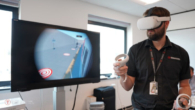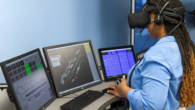
Simulation Weekly News
⊲ Last Week’s Sim News Summary ⊳ In a significant development for predictive modelling, Google’s DeepMind announced its “Weather Lab” AI model demonstrated superior accuracy in short-range forecasts for Hurricane Erin, outperforming traditional physics-based and consensus models, particularly in two-day intensity forecasts, suggesting AI’s potential to soon rival or surpass conventional meteorological methods.
Meanwhile, the automotive sector saw XPeng introduce the “Road Rage Reliever,” an augmented reality (AR) system that projects emojis onto the road via the windshield, aiming to provide drivers with a less aggressive outlet for frustration, though its impact on distraction is still being evaluated.
For military applications, Bohemia Interactive Simulations (BISim) secured a five-year enterprise licence to deliver its Digital Virtual Trainer (DVT) platform to the Canadian Army, enhancing operational preparedness through mission rehearsal, scalable virtual training, and detailed terrain generation.
Looking ahead, China unveiled an ambitious five-year plan to become a global leader in brain-computer interface (BCI) development by 2030, with core breakthroughs targeted by 2027, focusing on domestic innovation across medical and consumer applications.
The competitive landscape for extended reality (XR) headsets is heating up, with Samsung’s “Project Moohan” XR headset anticipated to launch on 29 September 2025, priced to compete with Apple’s Vision Pro and featuring a Snapdragon XR2+ Gen 2 chip and Gemini AI integration. Simultaneously, Meta’s Hypernova smart glasses are reportedly launching in September 2025, aiming to embed the metaverse into daily life via AI, gesture control, and partnerships with fashion brands like Prada.
Finally, in energy, a collaboration using digital twin technology revealed a consistent 4% discrepancy between reported and actual battery health, a crucial detail often obscured by standard battery management systems that can impact dispatch decisions and warranty outcomes.








